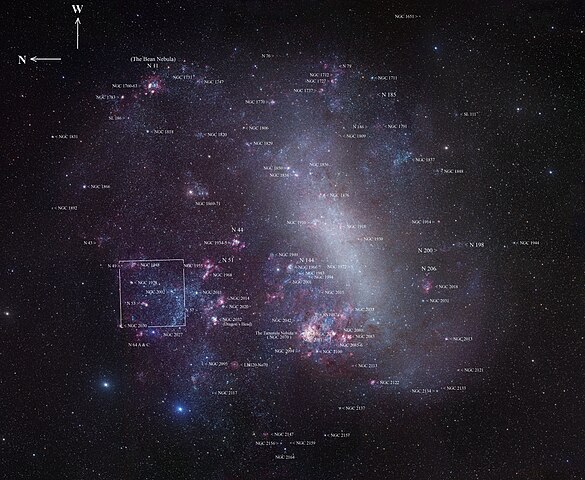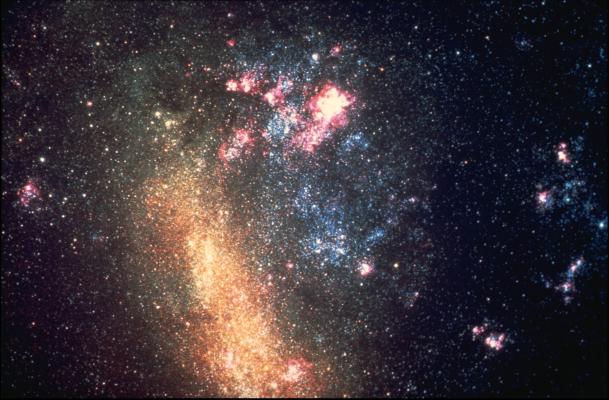
Image 1 Caption: "This image shows the entire Large Magellanic Cloud (LMC), with some of the brightest astronomical objects marked. The field of view (FOV) is ∼ 10° across and the directions of the equatorial coordinate system are indicated. The field of the new MPG/ESO 2.2-meter telescope image is indicated with a square outline." (Somewhat edited.)
Features:
- Yours truly thinks Image 1 is enhanced
true color.
There is a lot of
blue and
pink
light, but to the
naked eye
(either from the ground or in space),
the Large Magellanic Cloud (LMC)
would probably just look white.
Hm, Image 3 below makes the
Magellanic Clouds look
bluish, but
Image 3 does NOT look
exactly true color either:
the stars all have some coloration.
- The Large Magellanic Cloud (LMC)
is in constellations
Dorado
and Mensa
and the Small Magellanic Cloud (SMC)
is in constellations
Tucana
and Hydrus.
- The LMC
and SMC
(i.e., collectively the Magellanic Clouds)
are dwarf irregular galaxy
(both are Irr I's)
orbiting
the Milky Way: i.e.,
they satellite galaxies of
the Milky Way.
Actually, the LMC can also be considered the prototype of the rather specialized galaxy type the Magellanic spiral galaxies which have only 1 spiral arm.
- The LMC
is at distance ∼ 50 kpc
(2018 precise value:
49.97 kpc = 163.0 kly from the Solar System): see
Wikipedia: Large Magellanic Cloud),
and so is probably within the Milky Way's
dark matter halo
(see
Wikipedia: Milky Way: Gaseous halo;
Wikipedia:
Dark matter halo: Milky Way dark matter halo).
- The LMC
was the closest known other galaxy
until the
Sagittarius Dwarf Spheroidal Galaxy
(which is a
dwarf spheriodal galaxy (dSph)
wouldn't you know it)
was discovered in 1994 at 20(2) kpc
(65(7) kly)
from the Solar System
(see Wikipedia:
Sagittarius Dwarf Spheroidal Galaxy)
and the Canis Major Dwarf Galaxy
(a dwarf irregular galaxy) in
2003
at about 7.7 kpc (25 kly) from
the Solar System
and 13 kpc (42 kly)
from the Galactic center
(see Wikipedia:
Canis Major Dwarf Galaxy).
Why were the Sagittarius Dwarf Spheroidal Galaxy and Canis Major Dwarf Galaxy discovered so late in history? They are both small, faint, and in the case of the Sagittarius Dwarf Spheroidal Galaxy, somewhat aligned with the Milky Way disk, and so partly obscured by the interstellar dust in the Milky Way disk (see Wikipedia: Sagittarius Dwarf Spheroidal Galaxy: Features).
- Image 2 Caption: A close-up including the Tarantula Nebula (AKA 30 Doradus) (a large H II region) with apparently somewhat enhanced colors and ∼ 180° rotated compared to the Image 1. See description below.
- The most prominent pink region is the Tarantula Nebula (AKA 30 Doradus) which is a giant H II region. Core-collapse supernova SN 1987A occurred on the outskirts of the Tarantula Nebula (see Wikipedia: Tarantula Nebula: SN 1987A).
- Both LMC and SMC are naked-eyed astronomical objects in the southern hemisphere of celestial sphere (i.e., the southern celestial hemisphere) and were always been known to southern observers throughout prehistory.
- Image 3 Caption: On Cerro Paranal in the Atacama Desert of northern Chile is European Southern Observatory's (ESO) Paranal Observatory with Very Large Telescope (VLT). There was was taken this high-sensitivity panoramic photograph showing Milky Way and on the left the LMC and the SMC. On the right is the VLT's Unit Telescope 1.
- It was once thought that al-Sufi (903--986, in Europe AKA Azophi Arabus) mentioned the Large Magellanic Cloud in his The Book of Fixed Stars (c.964), but this seems a mistaken conjecture (Wikpidia: The_Book_of_Fixed_Stars: Influence; Wikipedia: Large Magellanic Cloud: History of observation). In the historical record, the first mention of the Magellanic Clouds was by Amerigo Vespucci (1454--1512) 1503--1504 under the names the 2 bright Canopes (see Wikipedia: Large Magellanic Cloud: History of observation). Ferdinand Magellan (1480--1521) on the first circumnavigation of the Earth (i.e., the Magellan-Elcano circumnavigation (1519--1522): Magellan himself died in mid-voyage in the Philippines) finally brought them into the generally-known historical record (see Wikipedia: Large Magellanic Cloud: History of observation).
-
Images:
- Credit/Permission: ©
Robert Gendler (1957--),
ESO
2010
(uploaded to
Wikimedia Commons
by User:Lithopsian,
2016) /
CC BY-SA 4.0.
Image link: Wikimedia Commons: File:Eso1021d.jpg - Credit/Permission: ©
NOAO,
AURA,
NSF,
before or circa 2010 /
NOAO/AURA Image Library Conditions of Use.
Download site: NOAO Images: Large Magellanic Cloud. Image link: Itself.
- Credit/Permission: ©
ESO
Yuri Beletsky,
2011
(uploaded to
Wikimedia Commons
by User:Jmencisom,
2011) /
CC BY-SA 3.0.
Image link: Wikimedia Commons: File:Panoramic Large and Small Magellanic Clouds.jpg.
File: Galaxies file: galaxy_lmc.html.

